One thing above all others makes my kids happy: Canadian Bacon and Pineapple Pizza. (I’ll admit, I’m fond of it, too.) So, confident in my general bacon-making abilities I embarked on a Canadian Bacon making experiment.
I’m happy to report that homemade Canadian Bacon is, if anything, even easier than belly bacon and tastes great in all sorts of things – diced up with eggs, sliced thin on a sandwich, cubed up in a soup with beans. And, yes, it makes a damned fine pizza topping.
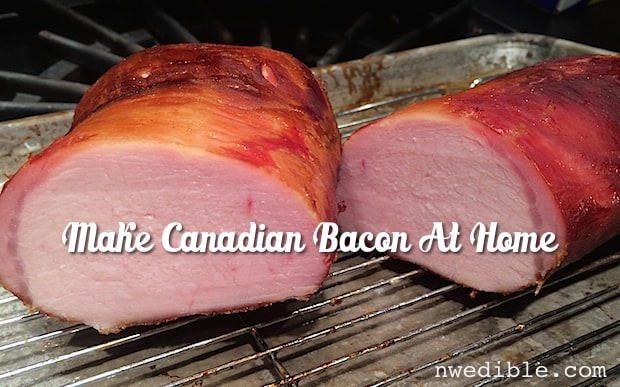
A Bacon By Any Other Name
In the United States we think of bacon as the cured, smoked belly of a pig. What we Americans call Canadian Bacon is brine-cured, smoked pork loin. It’s closer to “Back Bacon” and has a texture more like lean ham than belly bacon.
Canadian Bacon has nothing to do with Canada as far as I can tell – maybe some of my readers North of the border can chime in. In Canada there is a traditional product called peameal bacon which is a brined, unsmoked pork loin rolled in yellow crushed dried peas or cornmeal. I think this is what evolved into what we here in ‘Murica know as Canadian Bacon.
In any event, what we’ll be making today is made from the loin of a pig, and it’s both delicious and very straightforward.
Ok! Let’s Get Started!
Making Canadian Bacon at home is easy – if you’ve ever brined a Thanksgiving turkey, this is way less hassle than that.
You’ll need a whole pork loin. The loin is a lean, cylindrical muscle tucked right up alongside the spine. It’s a common cut that is easy to find at good butchers, grocery or warehouse-type store. If you buy or raise your pig as a whole or half animal think a bit about if you are willing to give up the other premium cuts from the loin primal to make Canadian Bacon. Those include pork loin roasts, loin chops and pork porterhouse steaks.
You’ll need common ingredients and spices. Details in the actual recipe.
Just like when we made belly bacon, we need pink curing salt and a way to smoke the pork. These two require a bit of planning ahead, so here’s what you should consider.
1. Pink Salt
Pink salt is a special curing salt that includes sodium nitrite. It keeps cured products safe from botulism, and makes your Canadian Bacon pink and juicy instead of pork-chop colored. Order it online. This is what I use.
This recipe calls for what seems like an insane amount of pink salt, and I’ll admit I balked a bit at the quantity involved when I first tested this recipe. After researching, I learned that wet brine cures for items like Canadian Bacon and ham require a much larger amount of pink salt than items like belly bacon that get cured with a dry rub. The reason is simple dilution from the water content of the brine.
If nitrites really freak you out, as long as you keep this product refrigerated at all reasonable times during curing and processing, the total smoking time is less than 2 hours, you keep your smoked pork loin refrigerated and freeze the extra, you can skip the pink salt. But what you make won’t be Canadian bacon – it’ll be smoke-roasted pork. Still super delicious, but more perishable and not quite the same, flavor-wise.
The only thing about pink salt that bothers me is the dye that turns it pink. The actual nitrites themselves don’t worry me at all. I’ve included my footnotes on pink salt and nitrates from the belly bacon tutorial at the end of this post so you can see where I stand and then make your own decision.
2. Smoker and Woodchips
I’ve made this Canadian bacon, or slight variations of it, three times now. In the photos that follow you’ll see me using the small “Little Chief” Electric Smoker given to me years ago by my sister and brother-in-law. It’s an older version of this model. We have since upgraded to an electric smoker (this one) and OMG the difference is incredible. We’ve run a lot of smoked meat since we got our new smoker and it’s done just great.
My dad came over and said our smoker reminded him of the set-up his father had. My grandpa converted a broken refrigerator (or maybe upright freezer) into a smoker by drilling a couple of holes into it and adding an electric hot-plate to the bottom. The chips sat on a tin pie plate on top of the hot plate. So if you are handy, you might be able to rig-up a DIY smoker on the cheap.
(Personal side note: my grandpa grew the best tomatoes I’ve ever eaten, spray-painted every tool he ever owned bright red and liked to say “You need to have a certain amount of shit hanging around.” When he passed away, my father opened up his garage. It was jam-packed with an uncountable number of things, all painted red.)
If you like this sort of thing, eventually you’ll want your own fancy smoker – something insulated with adjustable temperature controls and an auto-shut off timer. But in the meantime, there are a bunch of other ways to rig up a temporary smoker. Here are a few:
For wood, I used bags of hardwood apple chips from the grocery store, like these. They aren’t too expensive. I used maybe a quarter of a $5 bag to smoke a full pork loin. Apple wood with pork is a natural, but use what you like.
Making Canadian Bacon: Step by Step with Photos
Make your brine. This is as simple as bringing all the ingredients up to a simmer just to ensure all the salt is dissolved. I’ve played around with slight variations on the aromatics in the brine and all versions have turned out well. You can also scale this brine as needed. Just keep the ratio of water, salt, sugar and pink salt the same. Let the brine cool all the way and pop it in the fridge to chill before you use it.

While your brine is cooling, meet your meat!
Get yerself a full pork loin. It should weigh about 10 pounds. A bit more or less isn’t that big of deal, but if you have some massive 14 pound pork loin, you may have to cut it into thirds and scale up the brine to compensate. Alternatively, if ten pounds of Canadian bacon sounds intimidating, halve the brine quantity and use a 4 or 5 pound center-cut pork loin roast instead of the full loin.
Trim up the pork loin. After some debate with myself I left the silverskin on the loin on this batch. I wanted to keep that thin layer of fat. This was a risk – silverskin can be impossibly chewy but it turned out fine – no rubber band quality. So I say trim your pork loin and remove visible silverskin but don’t strip it of fat to do so.

If you are using the full lion, cut it in half as shown below and place each half in a heavy-duty, gallon-size zip-top plastic bag. If you are using a 4 or 5 pound roast, you’ll only need one bag. Duh.
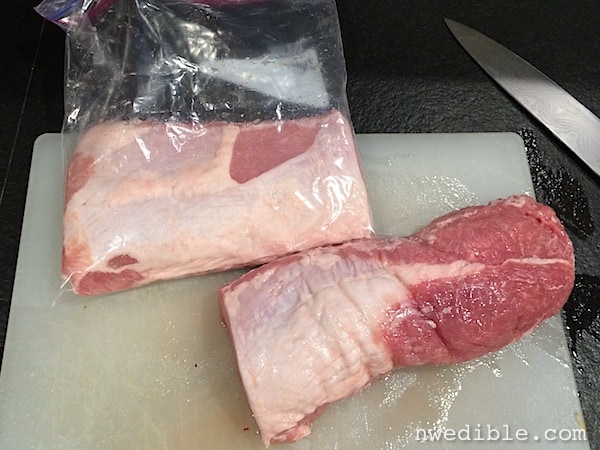
Add the cold brine to the bags with the pork loin, dividing up the brine equally and trying to get the aromatics more-or-less evenly represented in the bags, too. Squeeze as much extra air out as you can and try to get the meat fully surrounded by the brine.

Pop the brining pork loin in the fridge and leave it there for 3 to 4 days. If your chunk of pork loin is small, err on the side of a little less time and if it’s jumbo, err on the side of a little more time. Don’t exceed 5 days though or your loin will be too salty. Once a day, or when you think of it, give the bag a little flip to keep the meat brining evenly.

When Brine Time is up, it’s time for the fun part: drying and smoking. Before you smoke meat (or fish), the outside of the meat should be so dry that it feels a bit tacky. This layer of dry meat is called the pellicle and is important for good smoke flavor and color. To form the pellicle, you’ve got two options:
Pellicle Option #1: Slow, Easy and Health Department Approved
Rinse off your brined pork loin, then pat dry with a lint free towel. Set the loin pieces on a cooling rack set over a sheetpan and place the loin pieces uncovered in the refrigerator for a day or so.
Pellicle Option #2: Faster, More Work, Freaks Out The Health Department People
Rinse off your brined pork loin, then pat dry with a lint free towel. Set the loin pieces on a cooling rack set over a sheetpan and place the loin pieces on your counter. Set a big fan in front of the loin pieces and dry them in front of the fan, turning the loin pieces periodically so they dry uniformly.
Your loin isn’t going to spoil, since it just spent 4 days absorbing salt and nitrite, but don’t be stupid. Don’t dry your pork at room temp in summer in Arizona in a house without AC. And don’t let the drying go on more than two hours or so – if you don’t have a powerful fan that can get the job done in that timeframe, go with the Slow Dry Method.
Whatever method you opt for, make sure the pork loin has full air flow all around it and isn’t touching anything.
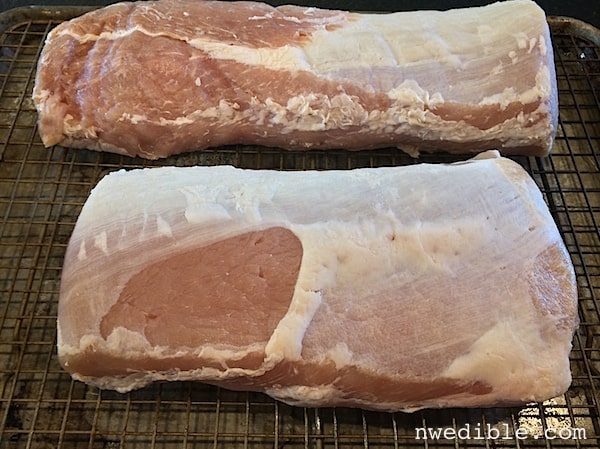
Now it’s time to smoke! Get your smoker set up and loaded with applewood chips or your chips of choice. Different smokers require slightly different set-ups, so just follow the instructions for your particular smoker. I use dry smoke. As a reader commented on the big bacon post, dry smokes and wet steams.
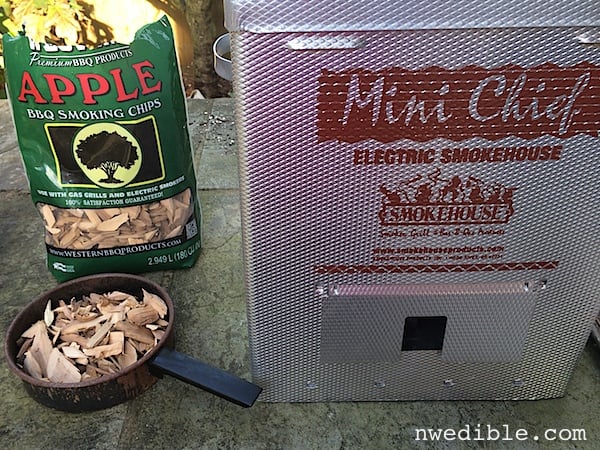
Load your brined, dry pork loin into your smoker and hot smoke until the pork hits an internal temperature of 150-degrees. If you are using a smoker with a temperature control, set your smoker to somewhere around 225-degrees.


When your Canadian bacon is fully cooked but juicy with a beautiful smoked exterior, remove it from the smoker.
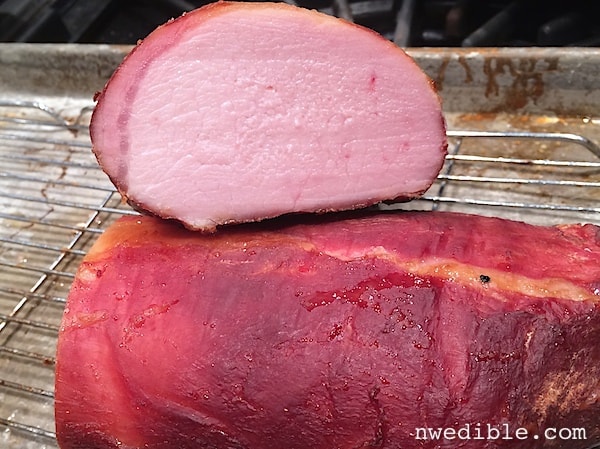
If you possibly contain yourself, wrap the Canadian bacon well and let it chill well before slicing into it. I did not have that level of self control. This stuff is incredible. It will last for a few weeks in the fridge, and if you wrap it well in reasonable-sized hunks you can freeze it for 6 months.
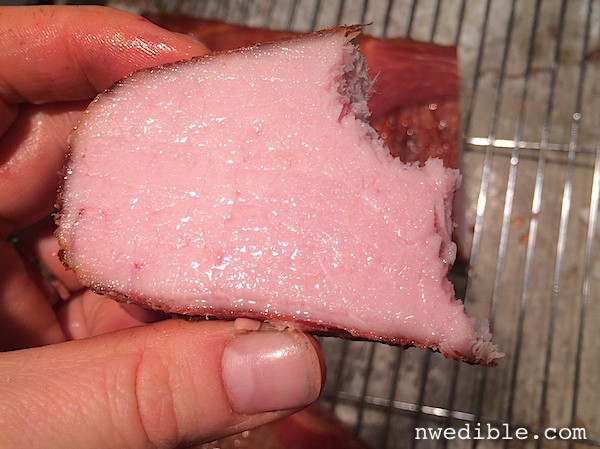
Printable Canadian Bacon Recipe
Adapted very lightly adapted from Micheal Ruhlman’s Canadian Bacon recipe at Ruhlman.com
Canadian Bacon At Home
Ingredients
For the Brine
- 1 gallon water
- 6.4 oz salt (This is 1-1/4 cups of the Diamond Crystal brand Kosher salt I use)
- 40 grams / 3 tablespoons pink salt (6.25% sodium nitrite curing salt)
- 1/2 cup maple syrup
- 1/2 cup sugar
- 8 garlic cloves, peeled and rough chopped
- 4 fresh or dried bay leaves
- 1 tbsp dried thyme, or a generous handful of fresh thyme
- 1 tbsp whole black peppercorn
- Juice of 2 lemons
For the Canadian Bacon
- 1, 8-to-10 pound pork loin
Instructions
- Combine all the brine ingredients in a large, non-reactive pot. Stirring occasionally, heat the brine over medium heat until the salt and sugar are fully dissolved. Let the brine cool, then pop it in the fridge to chill.
- While your brine is chilling, trim the pork loin of any excess fat and slice in half to form two, 4-to-5 pound cylinders. Put each piece of pork loin in a heavy duty, gallon-size freezer bag. Divide the brine and the aromatics evenly between the bags, squeeze out excess air and seal the bags well.
- Brine the pork in the the refrigerator for 3 to 4 days, flipping the pork periodically to ensure an even brine.
- Rinse and dry the pork, then allow to dry to form a pellicle.
- Hot smoke the pork at 200 degrees until the internal temperature of the pork reaches 150 degrees.
Footnote: Pink Salt, Prague Powder, Nitrites, Etc.
Regular readers will remember this footnote from it’s original appearance in the Giant DIY Bacon Tutorial. If you already know my take on this stuff, feel free to skip.
Pink Salt, also called Prague Powder, InstaCure or DQ Salt is a curing salt. You don’t use it for flavoring or seasoning – you use it to preserve meat and a little goes a long way.
It’s called Pink Salt because it is dyed pink so no one mistakes it for table salt. It is not the same as Himalayan pink salt! I saw a website telling people they needed to use Himalayan Pink Salt to cure their meats and I almost choked on my slab of pate. Not the same thing! So, to emphasize: Himalayan salt – or any other fancy boutique finishing salt of any color at all – is not what you need here.
There are two standard formulations of curing salt.
Prague Powder #1 (also called InstaCure #1 and DC Cure #1) contains table salt and 6.25% sodium nitrite and is used for sausages, cured meats, pates, deli meats, et.c that are cooked – smoked, baked, roasted, canned, whatever. Basically any cured meat that isn’t long-aged like a dry-cured salami. This is what we use when we make Canadian bacon. You can get it here.
Prague Powder #2 (also called InstaCure #2) is used for long aged dry-cured meats like prosciutto and hard salami. It has table salt, sodium nitrite (6.25%) and sodium nitrate (1%). The nitrate acts as a kind of slow-release preservative for very long-cured meats. We don’t use it to make bacon or other short-cured items.
“Wait!” I hear some of you saying, “Nitrites! Oh my God, evil toxic additives.” Hold on a second – before you slam your laptop lid in disgust, let me break down my position on Pink Salt for you.
Remember our old frienemy Mr. Botulism Toxin? (See: How Not To Die of Botulism) Did you know that botulism was first described “as a ‘sausage poison’ and ‘fatty poison’, because the bacterium that produces the toxin often caused poisoning by growing in improperly handled or prepared meat products.” (Wikipedia.) Even botulism’s name comes from a cured meat product: botulus is Latin for sausage.
Sodium nitrite in the form of pink salt, when used according to established standards, prevents the growth of C. Botulinum and the development of the botulism toxin in cured meats. That’s why it’s in there. As an added bonus, the nitrite enhances color, flavor, and texture in the cured meat.
Okay, so on one hand we have this established risk of botulism growth in improperly cured meat products. On the other hand we might have the potential risk of nitrites. So we have to ask ourselves, what is the risk from nitrites when used according to established guidelines? I believe the answer is – little to none, but of course this is something you should investigate if it concerns you. For more info, I recommend The “No Nitrites Added” Hoax by Micheal Ruhlman. I am, personally, firmly in the pro-Pink Salt category.
Related Stuff…
(These are affiliate links. Full financial disclosure here.)
Charcuterie: The Craft of Salting, Smoking, and Curing and Salumi: The Craft of Italian Dry Curing, both by Michael Ruhlman. If you want to go deeper into cured meats, you would be hard pressed to find a more enthusiastic guide than Ruhlman in these two books. Also check out his excellent personal website.
Pink Salt. Remember, you want Prague #1 for Canadian bacon and everything cured that isn’t long-dried. This link goes to the same pink salt I use.
Wood Chips. I like Applewood because it’s mild and has a fruity note that complements pork wonderfully. But play around – there are lots of different kinds of smoking wood.
Dedicated Smoker. If you have the room and the funds, there are a lot of options out there. I love my Masterbuilt Electric Smoker and can recommend it completely if you have the money and space for a dedicated smoker.
971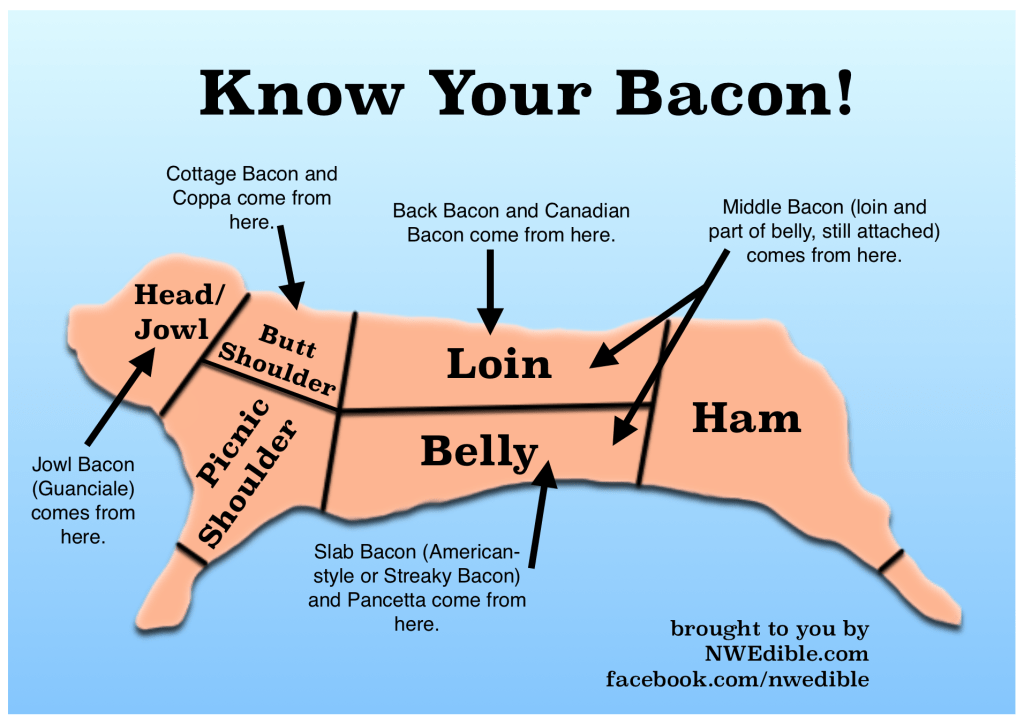
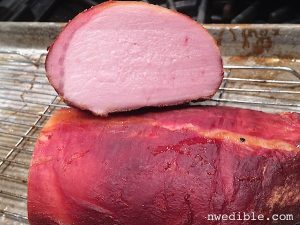
Just sent the link to this post to my husband. His one-word response? “Absolutely!!”
We’re still tossing up between having the butcher do our first pig or do it ourselves – all the way through this I kept getting mental flashes of Piglet and how bits of him would translate to the photos. We have a couple of months yet, so i think some more books would be a good start. Hubby’s keener on the home butcher idea than I am. Chickens, yes. Pigs are a lot bigger.
I had the butcher slaughter, skin (not my first choice, actually – would prefer scraped) and take my half hog down to basic primals, and I took it from there. And I requested all the weird bits – heart, head, tongue, etc. There isn’t much from a pig that can’t be eaten.
I don’t know your exact setup, but the important thing is to do the slaughter as quickly and humanely as possible. This is important ethically and for meat quality. Since it’s your first, would it be possible to have the butcher come to you, and do it together on site with guidance so you can learn for the future?
Erica, I’d love to know more about what you do with all of your pork pieces. We get a half-pig from a local farmer, but it still goes through the local butcher first, and our cut choices and curing options are limited. I’d be willing to take on the finishing, but don’t really know where to start in terms of talking to the butcher about what I want. Given the curing fees, though, I think it would save us some $ too. Thanks!
I love Canadian bacon, but the stuff is silly expensive per lb. Not sure if I have any sources of humane whole pork loin yet (need to inquire with the farmer I’ve bought pork steaks from previously), but if I do find one, I’m totally giving this a try!
Somewhat selfishly, have you tried any sausage recipes, specifically pepperoni? Or have a good first place to send me looking?
So glad to see you back on the blog, but also excited for the book!
Erica,
This is great! Thank you so much for sharing!!!
Wow, this is really easy! Now we really DO need to get a half hog!
Made this last week !Smoked on a Treager grill , Verry good next time i am going to make two or three !
I have a Traeger, too, Lee. I got some pork at Costco yesterday so I’m starting the brine today. I hope to have mine on my Traeger this weekend. 🙂
Wow–I am impressed! We no longer raise hogs. I usually purchase whole loins from our Fareway store when they are on sale. They do a great job of slicing and packaging the meat for me, I get roasts, boneless chops and tenderized slices. Sale price last week was less than $2.00 a pound, the best bargain in meat I have found to put in my freezer.
My husband is thinking about buying a smoker, I think I will encourage him. Canadian bacon would be another use for the loins.
A favorite sandwich in Iowa is breaded tenderloin–I just dip the slices in beaten egg, roll in crushed soda crackers and then fry until golden and thoroughly cooked .
Can I cold smoke Canadian bacon instead of hot smoke? also if I add cornmeal then I guess the bacon is not smoked?
I have cold smoked cured loin in the past. It is much more like lean ham and we ate much if it like prosciutto. It can also be pan fried after cold smoking.
Hi Erica.
I just wanted to let you know that you inspired my most recent post. Check it out here and thank you so much, it was delicious! https://tonymeetsmeat.wordpress.com/2015/07/06/smoke-roasted-pork-loin/
Tony
How long do you keep smoke to the Canadian bacon while it is on the smoker?
I like the method overall but you do make several common mistakes. First of all, botulism can’t grow inside a whole piece of meat. It’s spread via an air born spore and must be mechanically put inside the meat, like grinding it up for sausage. Since oxygen is immediately poisonous to botulism any spores that did try to start growing on the outside of the meat would immediately die. Curing of unground whole meat is more to slow down spoilage from non fatal microbes plus some that can be fatal and live in an oxygen environment like salmonella and listeria, both of which kills far more people annually world wide than botulism. And finally, prosciutto is made with ham, sea salt, lard, and patience. No curing salt. Salt alone has been used to cure and preserve meat quite successfully for thousands of years so nitrates and nitrites are not absolutely essential. I’ve been making my own prosciutto for decades without curing salt and have never had a problem with it, even storing my hams at 75 F for months and even years at a time and then eating it raw. Having said that, instead of using Prague powder one can also use Morton’s Tender Quick or Morton’s Sugar Cure, both of which contain salt, sugar, and sodium nitrate and sodium nitrite, but at lower concentrations than Prague Powder. I’ve been using both for decades in meats ranging from country hams to pastrami with excellent results. By adding sodium erythorbate or ascorbic acid as well the pretty pink color can be retained and sodium erythorbate converts the nitrosamines from nitrites into nitric oxide.A pinch of potassium sorbate will also help extend shelf life by inhibiting growth of molds and yeasts.
Hi!, Here in my country i cant find the pink salt, looking in the internet i found that this salt is composed by 93% of table salt + 7% of sodium nitrite. I found the sodium nitrite in a store, but i dont really know if its the same if i add it manually the nitrite to the water… Do you know about it??? thanks!
I have read this recipe and tried it but it says to use 6 teaspoons of Paque powder. for an 8lb loin Yet and not knocking the person who posted this but if you read most packager of “Pink Salt” and the USDA recommend no more then 1 teaspoon per 5 lbs. To much “Praque powder” can be much more dangerous then not having any at all
I am trying to make “Canadian Bacon” for the first time I added a few extra ingredients to the above recipe, most significant is the COSTCO mesquite seasoning and PENZI’s roasted garlic. My intent is to get a slightly smoked flavor.
I reduced the brine by 50% liquid volume. I have a lot left over. Can I refrigerate the un used brine and use it for my next batch of bacon?
Unlike this method, I prefer to cold smoke my brined Canadian Bacon. Applewood chips in a 15oz tin can with two 1/2″ holes on opposite sides, one near the bottom and one about middle. Fill the can with chips to the rim only. Put a 60-70 watt pencil soldering iron through the center hole, up past the screws that hold the tip in, not covering any cooling holes in the iron. (Make sure the iron has been heated up well and burnt the manufacturing coating off the heating element before you make smoke with it.) Place the can in your smoker away from the pork. Cover the tin can with a lid with a 1/2″ hole in it. I use a ceramic tile that I drilled a hole through. Close the lid of the smoker and plug in the iron. It takes a while to get the smoke rolling, but when it does, unplug the iron and leave it in the can. Monitor the temperature inside the smoker and keep it below 100F, you want to cold smoke it, not cook it. Experiment with the time, I do about 3 hours.
Hello there. I just used your recipe for my first cure – meat experiment (though I’ve smoked quite a bit), and was hard to be happy with the result except that she was hard to be happy with the result except…
It came out pretty salty for my taste. From looking around at other recipes and smoking forums, it appears that it’s extremely common to soak the loin in cool clear water for several hours after the brining (but prior to drying), sometimes changing the water a time or two. I literally just rinsed it for a
Minute or two after brining, but will take that to the next step, next time.
Thanks much for the detailed instructions, it came out great and texture and flavor, except for the saltiness.
Wow- autoCorrect did a number on that first paragraph! I meant to say I was generally very happy with the results except saltiness!
Wow!!! What a fantastic outcome. Best CB I have ever had and fairly easy to make. One surprise was the smoking time since all information only said go to 150F. I thought 4-6 hrs.
I have a Masterbuilt electric smoker and when I went to put the third feed of wood chips, after 23/4 hr, the temp was 149F. I let it go another 30 min. and took it off at 154F.
I will be making this again when pork loins go on sale.
I made the Canadian Bacon exactly as the recipe tells you. Never brined and smoked meat (together) before. It is absolutely amazing ! I paid $1.77/lb for beautiful pork loin. Thus less than $2 a lb for beautiful juicy fresh Canadian Bacon !! Yaaaaay!!
THANK YOU !!!!
Thank you for this recipe. Can’t wait to try it.
Well I looked over your a bit of your site and will follow it. However I totally disagree with your pink salt opinion.
There is plenty of evidence out there showing this lead’s to heart disease. Fix one problem and create another.
However naturally occurring nitrites do not seem to have this issue. I can tell you with a certainty the body understands nature when you eat or drink, but does not understand chemicals or stripped products like sugar, bleached flour, etc.
Thanks.